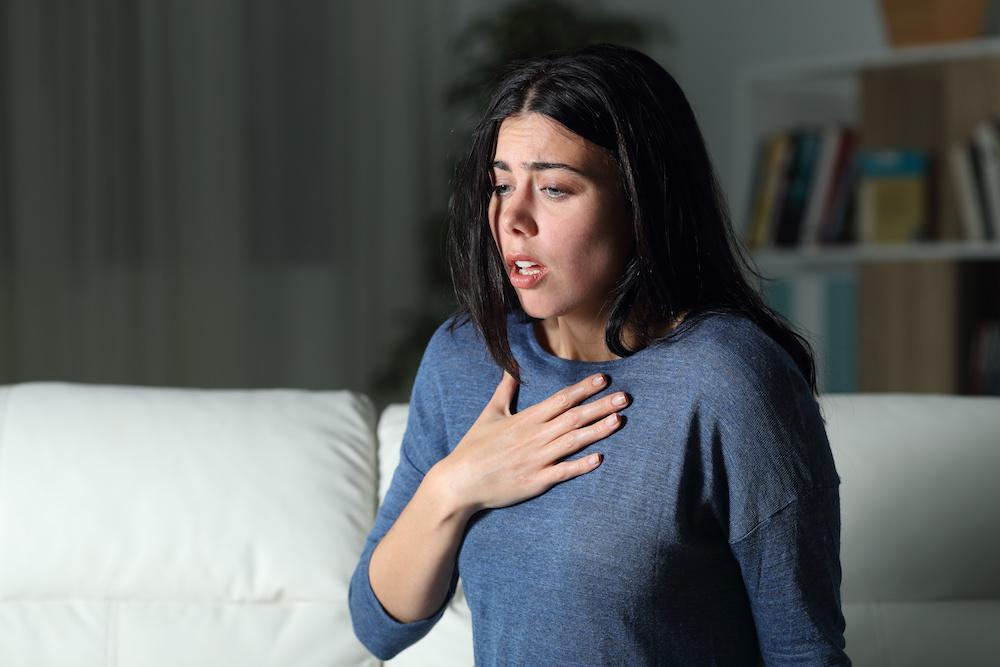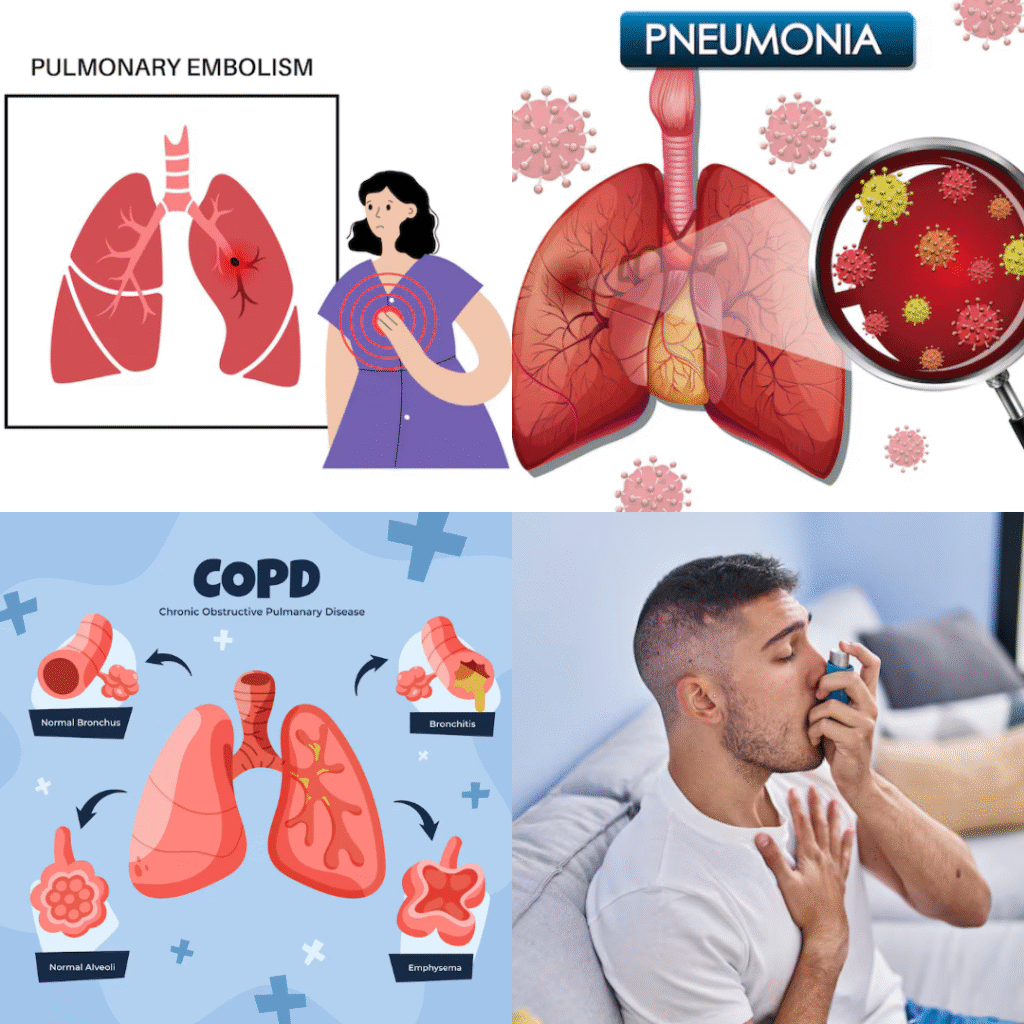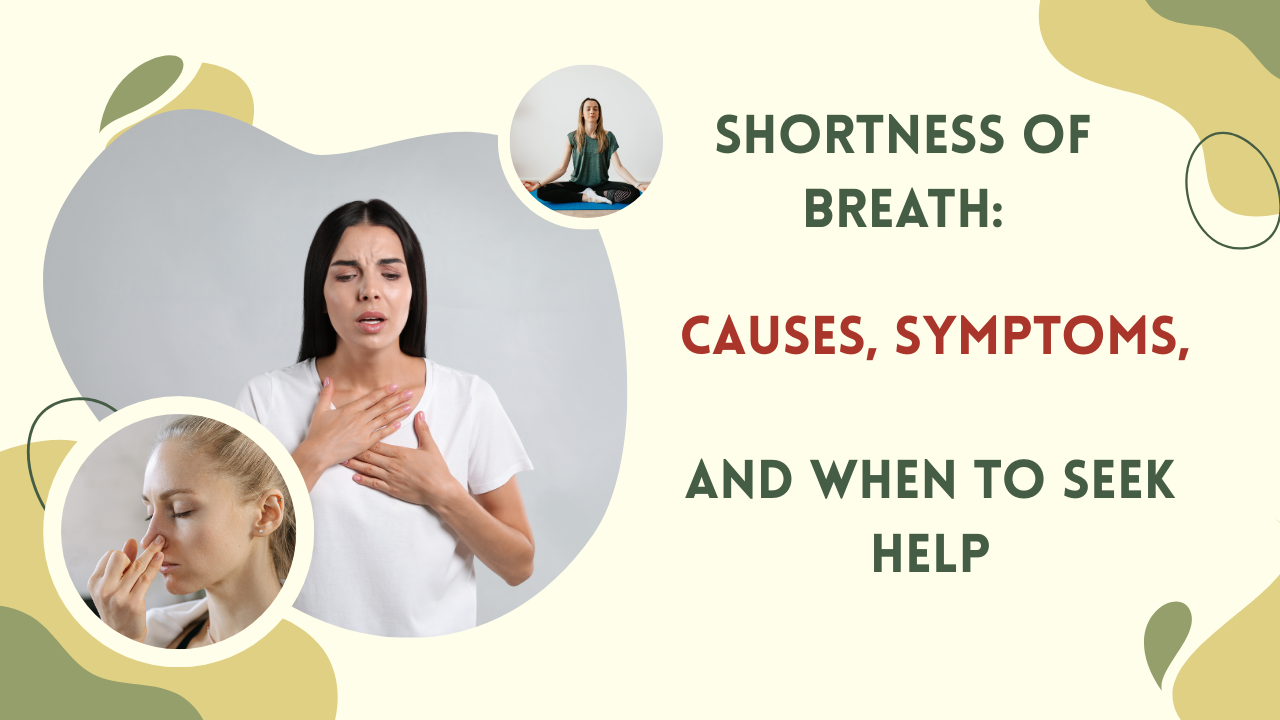Shortness of breath is a common symptom that affects people of all ages. It may feel like a tight chest, difficulty getting enough air, or a sense of being winded. This feeling, also known as dyspnea, can vary in intensity and may happen suddenly or develop over time depending on the cause.
In many cases, shortness of breath during exercise or physical activity is normal and not a reason for concern. However, if the breathlessness becomes more frequent or happens even at rest, it could point to a more serious health issue. Conditions like asthma, heart disease, lung infections, or anxiety can all lead to shortness of breath.
Persistent or sudden shortness of breath should not be ignored. It’s important to seek medical advice if breathing becomes difficult, especially if it’s accompanied by chest pain, dizziness, or swelling. Early diagnosis can help treat the root cause and prevent complications.
This article explores the various causes, symptoms, diagnostic methods, treatment options, and preventive strategies related to shortness of breath.

Understanding Shortness of Breath
Shortness of breath, also known as dyspnea, is the feeling of having trouble breathing. It is a personal experience that can vary widely between individuals. Some people may feel chest tightness, while others may struggle to take a deep breath or feel like they are suffocating.
This discomfort can happen suddenly or gradually and may be mild or severe. Shortness of breath is not a disease itself but a symptom of an underlying condition such as asthma, heart problems, or lung disease. Understanding how it feels can help doctors find the cause and suggest the right treatment.
Types of Dyspnea
Acute Dyspnea – This type of shortness of breath comes on suddenly and may be linked to serious health issues. It can occur in emergencies such as heart failure, a pulmonary embolism (blood clot in the lungs), or during a severe asthma attack. Immediate medical attention is often required.
Chronic Dyspnea – Chronic shortness of breath lasts for several weeks or even months. It is commonly associated with long-term health conditions like chronic obstructive pulmonary disease (COPD) or interstitial lung disease, and usually requires ongoing management.
Exertional Dyspnea – This form of shortness of breath appears only during physical activity. It may be one of the early warning signs of underlying heart or lung disease and should be evaluated if it worsens over time.
Orthopnea – This is shortness of breath that happens when lying flat. People often need to sleep propped up on pillows, and it is most often a sign of heart failure or fluid buildup in the lungs.
Paroxysmal Nocturnal Dyspnea (PND) – This involves sudden nighttime episodes of shortness of breath that wake a person from sleep. It is usually related to heart conditions and can be frightening and disruptive if not addressed.
Common Causes of Shortness of Breath

a. Asthma
Asthma is a long-term inflammatory condition that affects the airways, leading to repeated episodes of wheezing, chest tightness, coughing, and shortness of breath. It is often triggered by allergens, cold air, physical activity, or respiratory infections. Proper management and avoidance of triggers can help reduce symptoms.
b. Chronic Obstructive Pulmonary Disease (COPD)
COPD includes chronic bronchitis and emphysema and is commonly caused by long-term exposure to irritants like cigarette smoke. This condition results in narrowed airways and damaged lung tissue, making breathing difficult. Shortness of breath is a major and ongoing symptom in people with COPD.
c. Pulmonary Embolism
A pulmonary embolism occurs when a blood clot blocks an artery in the lungs. This sudden blockage can reduce blood flow and lower oxygen levels, causing sudden chest pain, rapid heartbeat, and severe shortness of breath. It is a life-threatening condition requiring emergency care.
d. Pneumonia
Pneumonia is a lung infection that inflames the air sacs, often filling them with fluid or pus. This impairs the lungs’ ability to exchange oxygen properly, leading to coughing, fever, and shortness of breath. Prompt treatment with antibiotics or antivirals is usually needed.
e. Interstitial Lung Disease
This is a group of lung disorders that cause inflammation and scarring (fibrosis) of lung tissue. The scarring makes the lungs stiff and less able to expand, resulting in progressive shortness of breath, especially during activity. Over time, breathing becomes more difficult.
Cardiac Causes
a. Congestive Heart Failure
Congestive heart failure occurs when the heart is no longer able to pump blood efficiently throughout the body. As a result, fluid can build up in the lungs, making it harder to breathe. This often leads to shortness of breath, especially when lying flat or during physical activity. It is a common cause of breathlessness in older adults.
b. Ischemic Heart Disease
Ischemic heart disease happens when blood flow to the heart muscle is reduced due to narrowed or blocked arteries. This condition can cause chest pain (angina) or even lead to a heart attack. The reduced oxygen supply affects the whole body and often results in shortness of breath, especially during exertion or stress.
c. Arrhythmias
Arrhythmias are irregular heart rhythms that can disrupt the normal flow of blood from the heart to the rest of the body. When the heart beats too fast, too slow, or unevenly, it may not pump enough blood, leading to symptoms such as fatigue, dizziness, and shortness of breath.
Other Medical Causes
a. Anemia
Anemia occurs when there is a shortage of red blood cells or hemoglobin, the protein responsible for carrying oxygen throughout the body. With less oxygen reaching the tissues, people may feel weak, tired, and experience shortness of breath, especially during physical activities or even mild exertion.
b. Obesity
Obesity can impact breathing by placing extra pressure on the lungs and diaphragm. This makes it harder for the chest to expand fully during inhalation, which can result in reduced lung capacity. As a result, individuals may often feel shortness of breath during movement or while lying down.
c. Anxiety and Panic Disorders
Mental health conditions like anxiety and panic disorders can lead to episodes of rapid breathing or hyperventilation. Even without any physical illness, the person may feel like they can’t catch their breath. This shortness of breath is often accompanied by chest tightness and a sense of panic.
d. Metabolic Acidosis
Metabolic acidosis is a condition where the body produces too much acid or the kidneys cannot remove enough acid from the body. In situations like diabetic ketoacidosis, the body tries to restore balance by increasing the breathing rate. This causes noticeable shortness of breath as the lungs work to reduce acid levels in the blood.
Symptoms Accompanying Shortness of Breath
While shortness of breath is a primary symptom, it is often accompanied by:

Chest pain or tightness
Wheezing
Cough (dry or productive)
Cyanosis (bluish skin/lips)
Fatigue or dizziness
Swelling in the legs or feet
Rapid heartbeat
The presence of these associated symptoms can help narrow down the cause.
When to Seek Medical Attention
Shortness of breath may be a medical emergency if it:
Begins suddenly and is severe
Occurs with chest pain, fainting, or confusion
Happens with swelling of the face or throat
Is associated with high fever, chills, or cough with colored sputum
Is worsening over time or impacts daily activities
Prompt evaluation by a healthcare provider is essential in these situations.
Diagnostic Approach
A thorough evaluation for dyspnea includes:
Medical History and Physical Examination
Onset, Duration, and Progression
When evaluating shortness of breath, it’s important to consider when the symptom started, how long it has lasted, and whether it is getting better or worse over time. A sudden onset may suggest an emergency, while a slow progression might point to a chronic condition.
Triggers and Relieving Factors
Understanding what makes shortness of breath worse or better can help identify its cause. For example, physical activity, allergens, or lying down might trigger symptoms, while rest or medication could bring relief. These patterns provide helpful clues during diagnosis.
Smoking, Occupation, Travel, and Environmental Exposure
Personal habits and environments play a major role in respiratory health. A history of smoking, exposure to dust or chemicals at work, recent travel, or contact with polluted air can all contribute to shortness of breath and may point to specific lung conditions.
Family History of Lung or Heart Disease
A family history of conditions like asthma, COPD, or heart disease can increase the risk of experiencing shortness of breath. Genetic links can help doctors look deeper into potential inherited causes.
Listening to the Lungs for Wheezing, Crackles, or Reduced Air Movement
Doctors use a stethoscope to check for abnormal lung sounds. Wheezing might indicate asthma, crackles can suggest fluid buildup, and reduced air movement may point to blockages. These sounds are vital in identifying the cause of shortness of breath.
Heart Rhythm and Sounds
Listening to the heart can reveal problems like irregular rhythms or murmurs. Abnormal heart function can reduce blood flow and oxygen delivery, leading to shortness of breath and related symptoms.
Diagnostic Tests

a. Pulse Oximetry
Pulse oximetry is a quick, non-invasive test that measures how much oxygen is in your blood. It involves placing a small device on your fingertip. This test helps determine if shortness of breath is related to low oxygen levels in the body.
b. Chest X-ray
A chest X-ray is often one of the first tests done when evaluating shortness of breath. It can reveal signs of lung infections, fluid buildup, enlarged heart, or tumors that may be affecting breathing.
c. Electrocardiogram (ECG)
An ECG checks the electrical activity of the heart. It can detect heart rhythm issues, previous heart attacks, or signs of ischemia—all of which may contribute to shortness of breath, especially during exertion.
d. Pulmonary Function Tests (PFTs)
These tests measure how well the lungs are working by assessing airflow and lung volume. Pulmonary function tests are especially useful in diagnosing causes of chronic shortness of breath like asthma or COPD.
e. Echocardiogram
This is an ultrasound test of the heart that provides images of its structure and movement. It helps assess how well the heart is pumping and can identify problems like heart failure, which may lead to shortness of breath.
This is an ultrasound test of the heart that provides images of its structure and movement. It helps assess how well the heart is pumping and can identify problems like heart failure, which may lead to shortness of breath.
f. CT Scan of the Chest
A chest CT scan offers detailed images of the lungs and surrounding tissues. It is helpful in detecting causes of shortness of breath such as blood clots (pulmonary embolism), fibrosis, or tumors.
g. Blood Tests
Blood tests can check for conditions like anemia, infections, or metabolic disorders that may reduce oxygen delivery or affect lung and heart function, leading to shortness of breath.
Treatment Options
Treatment depends on the underlying cause:
Respiratory Conditions
Asthma/COPD: Inhalers (bronchodilators and corticosteroids), oxygen therapy, and lifestyle changes
Pneumonia: Antibiotics, rest, and fluids
Pulmonary Embolism: Anticoagulants (blood thinners), thrombolytics in severe cases
Interstitial Lung Disease: Anti-fibrotic agents, corticosteroids, and pulmonary rehabilitation
Cardiac Conditions
Heart Failure: Diuretics, ACE inhibitors, beta-blockers, and fluid restriction
Ischemic Heart Disease: Nitrates, antiplatelet agents, lifestyle modification, or surgical interventions
Arrhythmias: Medications, electrical cardioversion, or pacemaker implantation
Anemia
Iron supplements, vitamin B12/folate supplementation, or blood transfusions depending on severity and cause
Psychological Causes
Cognitive Behavioral Therapy (CBT), breathing exercises, anti-anxiety medications, and mindfulness training
Lifestyle and Home Remedies

Weight Management
Maintaining a healthy weight helps lower the strain on the lungs and heart. Reducing excess body weight can improve breathing efficiency and ease shortness of breath, especially during physical activity or while lying down.
Quit Smoking
Quitting smoking is one of the most effective ways to improve lung health. It slows the progression of lung diseases like COPD and reduces the risk of lung cancer. This can greatly lessen shortness of breath over time.
Avoid Triggers
People with asthma or allergies should avoid known triggers such as dust, pollen, smoke, or strong odors. Reducing exposure to these irritants can help control symptoms and prevent sudden episodes of shortness of breath.
Exercise
Regular physical activity strengthens both the heart and lungs. Over time, exercise can boost stamina and make breathing easier, helping reduce the frequency and severity of shortness of breath during daily activities.
Breathing Techniques
Practicing techniques like pursed-lip breathing and diaphragmatic breathing can help control breathing patterns. These methods are especially helpful during episodes of shortness of breath by making each breath more effective and calming the breathing rate.
Prevention Strategies
Healthy Lifestyle Choices
Balanced diet, regular exercise, stress management
Vaccinations (e.g., flu and pneumonia vaccines)
Managing chronic conditions like diabetes and hypertension
Environmental Control
Avoid exposure to pollutants, dust, and allergens
Use of air purifiers if needed
Routine Health Checkups
Early detection of heart and lung conditions
Monitoring of blood pressure, cholesterol, and blood sugar
Prognosis
The outcome for individuals experiencing shortness of breath depends on what is causing the symptom. If it is due to an acute issue like a pulmonary embolism or a heart attack, immediate medical attention is necessary. These conditions can become life-threatening if not treated quickly. Recognizing warning signs and acting fast can greatly improve the chances of recovery in such situations.
On the other hand, chronic causes of shortness of breath, such as chronic obstructive pulmonary disease (COPD) or heart failure, usually need ongoing care. With the right treatment and lifestyle changes, many people can manage their symptoms and live a more comfortable life. Regular check-ups, medications, and avoiding triggers are important steps in controlling shortness of breath. Early diagnosis and consistent medical care play a big role in improving long-term outcomes for those dealing with chronic respiratory or heart problems.
Conclusion

Shortness of breath is a symptom that should never be overlooked, especially when it happens suddenly, worsens over time, or comes with other troubling signs. Timely medical evaluation is crucial for identifying the underlying cause and preventing further complications.
While shortness of breath can be caused by mild factors like lack of physical conditioning or a simple respiratory infection, it can also indicate more serious health issues, such as heart disease or lung conditions. It is essential to understand these potential causes to seek appropriate care when necessary.
Adopting healthy lifestyle habits, like regular exercise, quitting smoking, and managing stress, can help reduce the risk of developing conditions that lead to shortness of breath. Staying informed and proactive with healthcare is the best approach for managing respiratory health and maintaining a good quality of life.
FAQs
- What are the common causes of shortness of breath ?
Shortness of breath can be caused by various factors, including respiratory conditions like asthma, COPD, or pneumonia, heart issues such as heart failure or ischemic heart disease, and even anxiety or obesity. It’s important to identify the underlying cause to determine the appropriate treatment. - When should I seek medical attention for shortness of breath ?
You should seek medical attention if shortness of breath occurs suddenly, worsens over time, or is accompanied by other symptoms like chest pain, dizziness, or swelling in the legs. These could indicate a serious condition, such as a heart attack or pulmonary embolism, that requires urgent care. - Can shortness of breath be caused by stress or anxiety ?
Yes, anxiety and panic attacks can lead to shortness of breath. Stress may trigger rapid breathing or a sensation of not being able to catch your breath, even if there is no physical disease involved. - How can I manage shortness of breath at home ?
If shortness of breath is mild and not caused by a serious condition, breathing exercises like pursed-lip breathing or diaphragmatic breathing can help. Staying active, avoiding smoking, and managing underlying conditions can also improve breathing over time. - Is shortness of breath always a sign of a serious problem ?
Not always. Shortness of breath can occur due to mild issues like physical deconditioning or a mild respiratory infection. However, it is important not to ignore persistent or worsening symptoms, as they could indicate a more serious health condition that needs medical attention.



